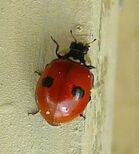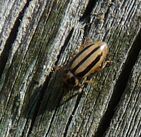Arthropods (Arthropoda)----Insects (Insecta)----Beetles (Coleoptera)----Polyphaga----Cucjoidea----Ladybirds (Coccinellidae)
Ladybirds got their name from the fact the common and well-known red species matched the colour of the Virgin Mary; they were orgrinally known as the Lady's bugs. Ladybirds come by many names such as Ladybugs, ladybeetles and Lucky bugs. These insects are well liked because of their love for eating aphids, scale insects, mealybugs and mites, which places them near the top of a gardener's "want" list, however not all species feed on aphids, some are herbivores (the Mexican bean beetle as an example, is also an agricultural pest) and some feed on fungi and mildew (such as the Twenty-spotted ladybird). When ladybirds first hatch from their pupa, they are pale yellow, and after a couple of hours they gradually gain their markings and true colours.
One fact that has eluded the majority of the world is that ladybirds do bite, but very, very rarely; if they do bite, you will know about it, I once got bitten by a small Two-spotted ladybird which resulted in a small <0.5cm red dot on my hand, one ladybird, an introduced species, called Harmonia axyridis in latin, bites as a habit; both adults and larvae bite very frequently when handled, pinch your arm as hard as you can, this is just what the bite feels like, just slightly less painful. Another thing ladybirds can do is "Reflex bleeding" this is when a ladybird secretes a orange or yellow blob of fake blood which smell deters predator (it doesn't smell that bad...) which both adults and larvae do. The ladybirds that are very tiny and feed on plants and fungi do not seem to reflex bleed.
The Cream-spotted ladybird is one of the most variable species, adults can have 18 black spots with either yellow or pink as a background, or they can be black with 18 small cream-coloured spots (presumably were its name comes from), or on very rare occasions they can be black with 2 red patches (not to be confused with Chilocorus sp.) I'm not sure if this melanic form occurs in Alberta yet.
Species[]
| Seven-spotted ladybird |  |
Two-spottted ladybird |  30th May, 2009. |
Parenthesis ladybird |  |
| Coccinella septempunctata | Adalia bipunctata | Hippodamia parenthesis | |||
| Thirteen-spotted ladybird |  |
Sinuate ladybird |  |
Cream-spotted ladybird |  |
| Hippodamia tredecimpunctata | Hippodamia sinuata | Calvia quatuordecimguttata | |||
| Hudsonian ladybird |  24th April, 2009 |
Painted Ladybird |  |
Episcopalian ladybird |  |
| Mulsantina hudsonica | Mulsantina picta | Macronaemia episcopalis | |||
| Twenty-spotted ladybird |  14th June, 2009 |
Micro ladybird |  |
American Eyed Ladybird |  |
| Psyllobora vigintimaculata | Microweisea misella | Anatis mali | |||
| Harlequin ladybird |  |
Mealybug destroyer |  |
Glacial ladybird 2 uncomfirmed |  Elevation: 2150ft~ |
| Harmonia axyridis | Cryptolaemus montrouzieri | Hippodamia glacialis lecontei? | |||
| Glacial Ladybird |  |
||||
| Hippodamia glacialis | |||||